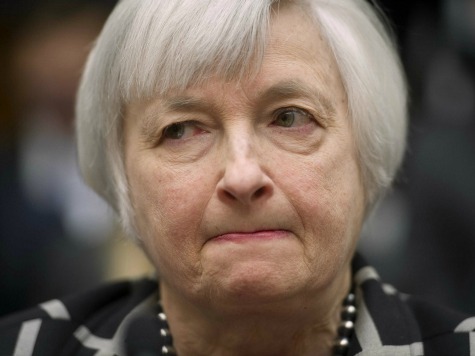
With jobs, wages, and the economy picking up steam, the Federal Reserve warned financial institutions in their April 29-30 Open Market Committee meeting minutes that they are planning to raise interest rates as inflation picks up.
“Participants generally agreed that starting to consider the options for normalization at this meeting was prudent,” according to the minutes. This means that the Fed governors shop at grocery stores and they know that food prices are going up fast.
Since Janet Yellen became Fed Chair, she has emphasized that she understands the Fed buying $3 trillion in government bonds and mortgages has pushed up the prices of stocks and real estate. Although the Fed’s stated policy has been that it will not begin raising its benchmark short-term interest rate — near zero since the crisis — until sometime next year, Yellen appears to be nudging that date forward:
In a joint session of the Federal Open Market Committee (FOMC) and the Board of Governors of the Federal Reserve System, meeting participants discussed issues associated with the eventual normalization of the stance and conduct of monetary policy. The Committee’s discussion of this topic was undertaken as part of prudent planning and did not imply that normalization would necessarily begin sometime soon. A staff presentation outlined several approaches to raising short-term interest rates when it becomes appropriate to do so, and to controlling the level of short-term interest rates.
For the first time, Chair Yellen started talking about the Fed’s use of aggressive “tools” to drain liquidity out of the banking system through what are called reverse repurchase agreements and the term deposit facilities.
Much of the Fed’s “zero-interest-rate-policy” (zirp) was designed to add international liquidity during the financial crisis. This month’s Fed statement emphasized the importance of returning to the U.S. long-term focus on reciprocal currency arrangements with the Bank of Canada, Bank of Mexico, Bank of England, Bank of Japan, European Central Bank, and the Swiss National Bank. What is politically interesting is that the Bank of China was not included in these key reciprocal arrangements.
The Fed commented, “Credit flows to nonfinancial corporations remained robust.” This seems to indicate that manufacturing is beginning to ramp-up production and businesses are taking out commercial and industrial loans to finance higher sales.
The regional Fed Boards also noted that “business contacts in many parts of the country were generally optimistic about economic prospects, with reports of increased sales of automobiles, higher production in the aerospace industry, and increased usage of industrial power.”
All of these economic indicators are positive for the economy and should be very encouraging for the pace of job growth. But Chair Yellen understands that the Fed has put a massive amount of monetary stimulus in the U.S. economy.
The good news is that the Fed’s stimulus is working. The bad news is that if the Fed leaves interest rates too low for too long, inflation will ignite. Then the Fed will have to substantially raise interest rates, which usually causes another recession. So far, Chair Yellen seems to be trying to get the Fed out of the stimulus business.

COMMENTS
Please let us know if you're having issues with commenting.